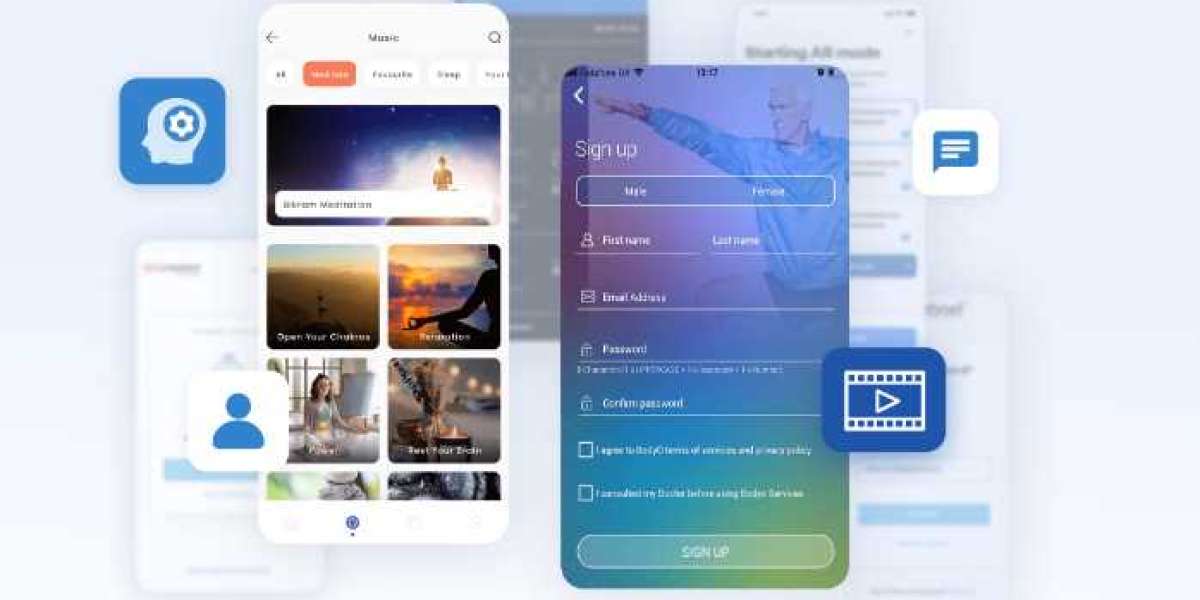In today’s fast-paced digital world, mental health apps have emerged as vital tools for supporting emotional well-being, providing therapy access, and tracking mental health symptoms. However, the effectiveness of such apps depends not only on their functionality but critically on how user-friendly their interfaces are. Designing intuitive, empathetic, and accessible user interfaces (UI) is essential for mental health app development.
Why User-Friendly Design Matters in Mental Health Apps
Mental health apps serve diverse users — from individuals experiencing anxiety and depression to those seeking stress management or therapy support. Many users turn to these apps during vulnerable moments, making it crucial that the app interface feels welcoming, easy to navigate, and non-intimidating.
A well-designed user interface promotes:
User engagement and retention: Intuitive design encourages continued app use, which is important for mental health improvements.
Accessibility: Users with disabilities or varying levels of tech literacy can benefit.
Trust and safety: Clear, calming design elements help users feel safe sharing sensitive information.
Therapeutic effectiveness: The easier it is to use the app, the more likely users will complete therapeutic exercises or self-assessments.
In mental health app development, focusing on UI/UX design is not just a technical requirement—it is a fundamental part of delivering effective digital care.
Best Practices for Designing User-Friendly Interfaces in Mental Health Apps
1. Prioritize Simplicity and Clarity
Mental health apps must avoid overwhelming users with too much information or complex navigation paths. Use a clean, minimalistic layout with clearly labeled buttons and intuitive navigation.
Clear Visual Hierarchy: Use font size, color, and spacing to emphasize important actions or information.
Consistent Layouts: Users feel more comfortable when interface elements behave predictably.
Avoid Jargon: Use plain language and simple terms for instructions or prompts.
Example: Instead of multiple nested menus, offer a straightforward home screen with the core features (e.g., mood tracking, journaling, therapy chat) easily accessible.
2. Use Soothing and Appropriate Visual Design
Colors, fonts, and imagery affect user mood and comfort significantly. Choose a color palette that is calming—such as soft blues, greens, or pastel shades—and avoid harsh, overly bright colors that may cause stress or discomfort.
Accessibility: Ensure color contrast meets WCAG standards to help users with visual impairments.
Fonts: Use legible, sans-serif fonts at readable sizes.
Imagery: Incorporate gentle, positive visuals, such as nature scenes or abstract calming patterns.
This empathetic approach fosters trust and a welcoming experience, crucial for users seeking mental health support.
3. Design for Accessibility and Inclusivity
A mental health app should be accessible to all users, including those with disabilities or limited technology experience.
Screen Readers: Make sure all interface elements are compatible with screen readers.
Text Alternatives: Provide alt text for images and icons.
Voice Commands and Audio Cues: Useful for users with motor difficulties or vision impairment.
Adjustable Text Size: Allow users to increase font size without breaking layout.
Language Options: Offer multiple language versions if possible.
By focusing on inclusivity, developers create a broader impact and adhere to ethical standards.
4. Facilitate Easy Onboarding and Guidance
First-time users of mental health apps may feel unsure or overwhelmed. An intuitive onboarding process helps users understand the app’s purpose, how to navigate it, and what to expect.
Interactive Tutorials: Step-by-step guides with prompts and highlights.
Progressive Disclosure: Introduce features gradually rather than all at once.
Tooltips and Help Buttons: Allow users to access help anytime.
Good onboarding reduces friction and increases the likelihood that users will return.
5. Build Privacy and Security Transparency into the UI
Mental health data is highly sensitive. Users must feel their privacy is protected and that the app is trustworthy.
Clear Privacy Notices: Use simple language to explain how data is collected, stored, and used.
Permission Requests: Ask for permissions only when necessary, and explain why.
Security Features: Visual indicators like lock icons reassure users about data protection.
User Control: Provide settings to control data sharing and account deletion.
Embedding privacy transparency into the design builds user confidence, encouraging openness and engagement.
6. Incorporate Emotional Design Principles
Mental health apps should engage users emotionally and provide comfort.
Personalization: Allow users to customize themes, set goals, or choose preferred content.
Positive Feedback: Use encouraging messages and progress indicators to motivate users.
Empathy: Design messaging and microcopy with compassion, avoiding blame or judgmental language.
This approach humanizes the digital experience, fostering a therapeutic connection even through a screen.
7. Optimize for Mobile and Multi-Platform Use
Most users access mental health apps via smartphones. Responsive design that works well on all screen sizes is a must.
Thumb-Friendly Controls: Place primary buttons within easy reach on mobile screens.
Offline Capabilities: Enable core features to work without constant internet.
Cross-Platform Sync: Support seamless use across mobile, tablet, and desktop if applicable.
Flexibility increases usability and user satisfaction.
8. Enable Seamless Communication with Professionals
Many mental health apps integrate teletherapy or chat support. The communication interface should be straightforward and reassuring.
Simple Messaging Interface: Clear input fields, read receipts, and easy access to history.
Scheduling: Integrate easy booking for sessions.
Notifications: Friendly reminders without being intrusive.
Designing communication tools with care strengthens the therapeutic alliance and user trust.
9. Test Thoroughly with Real Users
No design is complete without user feedback, especially from the target audience.
User Testing: Conduct sessions with diverse users, including people with mental health challenges.
Iterative Improvements: Use feedback to refine UI elements.
Usability Metrics: Track task success rates, time to complete tasks, and user satisfaction.
This real-world validation ensures the interface truly meets user needs.
The Role of Health App Developers in Mental Health App Design
Health app developers play a pivotal role in implementing these best practices during mental health app development. Beyond coding, developers must collaborate closely with UI/UX designers, mental health professionals, and users to create meaningful experiences.
Key responsibilities include:
Choosing appropriate frameworks for responsive and accessible UI.
Integrating security protocols aligned with HIPAA, GDPR, and other regulations.
Ensuring smooth performance on various devices.
Implementing analytics tools to monitor engagement and identify UX issues.
Developers who understand the sensitivity of mental health data and user experience can elevate the impact of the app beyond technology.
Conclusion
Designing user-friendly interfaces for mental health apps requires a delicate balance of simplicity, empathy, accessibility, and security. By prioritizing these principles, health app developers can create digital tools that users not only trust but actively engage with, leading to better mental health outcomes.
The future of creating a mental health app lies in compassionate, human-centered design backed by rigorous user testing and seamless technology integration. As the demand for digital mental health solutions grows, embracing these best practices ensures your app stands out as both effective and user-friendly.








